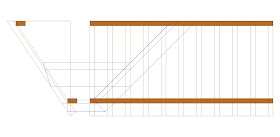Wednesday, December 31, 2014
Brain Melt 2014
Finishing up the last task model in Bernd Kupper's book, The new Book on the ancient knowledge of Roof Framing, Pent roof with Pointed Dormer, it feels like a brain melt looking at all the geometric lines. Lots of techniques to remember, when I build this task model next week.
Sunday, December 28, 2014
Plumb Hip Rafter or Inclined Rafter with Edge Bevel
In the last task model in Bernd Kupper's book, The new Book on the ancient knowledge of Roof Framing, Pent roof with Pointed Dormer, Bernd shows how the lower miter angle is developed for the plumb inclined rafter with edge bevel when it intersects the canted rafter. He uses the canted rafter's bottom edge in ground plan to develop the lines for the inclined rafter's lower miter angle. This is one of those situations when it helps to know how to develop the hip rafter trace angles on the hip rafter to check your geometric line development.
I never could get the canted rafters ground lines to work correctly, so I used the hip rafter trace angle geometry to find the lower miter angle on the inclined rafter with edge bevel.
Here's couple of drawings from Bernd. These should correct my mistakes.
Width of line for bottom edge of canted rafter in ground plan
30mm x sin(37.761235) = 18.371169
I never could get the canted rafters ground lines to work correctly, so I used the hip rafter trace angle geometry to find the lower miter angle on the inclined rafter with edge bevel.
Tried using the canted rafter DP tilt triangle for the canted rafter lines in ground plan, but the lines still would not line up correctly.
Tried rotating the canted rafter block in ground plan and still couldn't get the bottom edge of the canted rafter to align correctly. I'm probably drawing something wrong, just not sure where the mistake is in the drawing.
Here's couple of drawings from Bernd. These should correct my mistakes.
Apparently I had redrawn the plumb hip rafter too many times, without checking my construction lines. Bernd saw that they were not parallel lines and sure enough after redrawing the entire file the miter cut on the bottom of the plumb hip rafter that intersects the canted rafter is now correct.
One of the problems I had was drawing the bottom edge of the canted rafter in ground plan correctly. So, I used some trigonometry to rotate the rafter block precisely to locate the bottom edge of the canted rafter in ground plan.
Rafter block, 20mm x 30mm
Profile Slope Angle = 45°
Plan Angle = 30°
Hip Rafter Backing Angle = arcsin (sin Profile Rafter Slope Angle x cos Plan Angle)
Hip Rafter Backing Angle = arcsin(sin 45 x cos 30) = 37.761235
Width of top edge lines in ground plan
20mm x cos(37.761235) = 15.811388
30mm x sin(37.761235) = 18.371169
Saturday, December 27, 2014
Rising Purlin with Rafter Seat Cuts
Zimmerer Ausbildungs Zentrum Biberach
Pictures from the German Carpenters Training Centre in Biberach. This first task model looks small and simple enough. However, if you look closely the task model has a rising purlin, wall plate, with a plumb hip rafter, canted rafter and an inclined rafter with edge bevel. There's only a handful of Americans that can even draw out the geometry for an plumb jack rafter seat on the rising purlin. In sticked framed roofs, I've always lower the rising purlin, wall plate, to avoid cutting the compound seat cut on jack rafters.
Drawings for the second task model from the German Carpenters Training Centre in Biberach using Bernd's technique.
Pictures from the German Carpenters Training Centre in Biberach. This first task model looks small and simple enough. However, if you look closely the task model has a rising purlin, wall plate, with a plumb hip rafter, canted rafter and an inclined rafter with edge bevel. There's only a handful of Americans that can even draw out the geometry for an plumb jack rafter seat on the rising purlin. In sticked framed roofs, I've always lower the rising purlin, wall plate, to avoid cutting the compound seat cut on jack rafters.
Another picture from German Carpenters Training Centre in Biberach with a task model with jack rafter seat cuts on the rising purlins.
In the last task model in Bernd Kupper's book, The new Book on the ancient knowledge of Roof Framing, Pent roof with Pointed Dormer, Bernd shows a good drawing technique for developing the seat cut on the rafters on the rising purlin.
After starting the drawings of the task model from the book, I decided to see if the drawing technique for the seat cuts on the rising purlin would work on the task model from the German Carpenters Training Centre in Biberach. I'm not sure if this was the technique that used, but it worked pretty easily for me.
Drawings for the second task model from the German Carpenters Training Centre in Biberach using Bernd's technique.
Here's an example in a situation that I've come across before. With rafters crossing over the top of a sloping rake wall. Using Bernd's technique it makes it pretty simple to draw out the seat cuts for the rake wall, rising purlin. No more lowering the rake plates. The seat cut on the rafters crossing the rake wall, use the same angles we would use on the lower jack rafter claw on a hip rafter.






















































